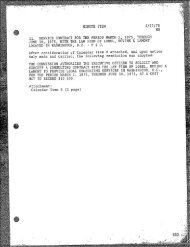Mooring Loads Due to Parallel Passing Ships - State Lands ...
Mooring Loads Due to Parallel Passing Ships - State Lands ...
Mooring Loads Due to Parallel Passing Ships - State Lands ...
Create successful ePaper yourself
Turn your PDF publications into a flip-book with our unique Google optimized e-Paper software.
In addition, significant work was required <strong>to</strong> design and construct a mooring rig<br />
that would allow surge and sway forces, as well as yaw moments, <strong>to</strong> be measured on a<br />
moored ship model. This measurement rig was designed and constructed concurrent<br />
with the development of the <strong>to</strong>wing rig. In fact, two test rigs were developed.<br />
The first test rig was constructed using a heavy aluminum frame and is shown in<br />
Figures 4 and 5. With this rig, square modular force blocks were mounted in the ship<br />
model and were attached <strong>to</strong> the aluminum frame using vertical guide rails running<br />
through roller bearings fore and aft. These restrained the model in surge, sway, and<br />
yaw while allowing heave and pitch motions. Surge and Sway forces were measured<br />
at both the fore and aft gage locations.<br />
While this test rig was used successfully in one test series (tests using one<br />
water depth of 4.9 inches), it proved troublesome and was eventually replaced.<br />
Problems arose due <strong>to</strong> occasional binding of the vertical rollers and due <strong>to</strong> use of the<br />
modular force blocks. These force blocks had 5 and 10 pound capacities and had<br />
difficulty resolving the small loads being experienced, which were sometimes on the<br />
order of 0.01 pounds.<br />
Figure 4. Original test frame used <strong>to</strong> measure mooring loads, viewed from <strong>to</strong>p<br />
NFESC TR-6056-OCN<br />
6

















